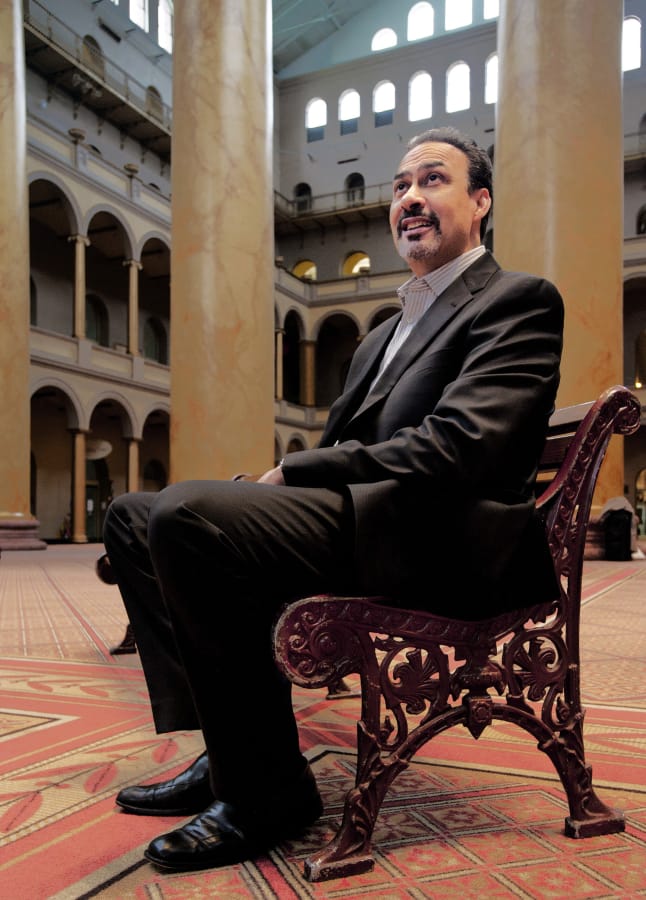Phil Freelon, an architect who led a design team that gave shape to the Smithsonian National Museum of African American History and Culture, which opened to critical acclaim on the National Mall in 2016 as a monument to black struggle and triumph, died Tuesday at his home in Durham, N.C. He was 66.
He had complications from amyotrophic lateral sclerosis, sometimes known as Lou Gehrig’s disease, said a son, Deen Freelon.
Since 1990, Freelon led an architectural firm in Durham that specialized in designing public buildings, including other cultural centers devoted to black life in Baltimore, Atlanta, Charlotte, San Francisco and Greensboro, N.C.
He led a consortium of several architectural firms — formally known as the Freelon Adjaye Bond/SmithGroup — that won the design competition for the National Museum of African History in 2009. The proposal was chosen, in a unanimous vote, over submissions from such renowned architects as Richard Meier, I.M. Pei and Norman Foster.
Freelon and the two other principal architects in the group, David Adjaye and Max Bond, were black. Bond died in 2009, just before the group won the competition.
Adjaye, born in Tanzania and raised in Ghana, was the lead designer. As lead architect, Freelon helped with the design and oversaw the technical aspects of the project, which included negotiating the thickets of bureaucratic Washington. Adjaye described him in 2010 as a “steady rock.”
Over a seven-year period, and at a cost of more than $500 million, Freelon and his group designed and built the 400,00-square-foot museum, which is adjacent to the Washington Monument. President Barack Obama was present for the museum’s groundbreaking in 2012 and when its doors opened four years later. Since then, nearly 5 million people have visited the museum.
New York Times architecture critic Michael Kimmelman pronounced it “the first really fine major public building of the century to rise in the nation’s capital.”
With its filigreed bronze-color exterior and its three-tiered corona, derived from a Yoruban architectural element from West Africa, the museum stands in striking — and deliberate — contrast to the white-marble edifices of so much of official Washington.
“We wanted the design to be meaningful beyond just a handsome building or a wrap around the exhibits,” Freelon told the Duke University Chronicle in 2016. “We felt it was appropriate to have something linked to the motherland. This is an African American museum, so the African aspect of it seemed appropriate.”
Every part of the museum’s design had cultural meaning, even the 17.5-degree angle of the edges of the three levels of the corona — the same angle at the top of the Washington Monument, only inverted.
The patterns in the building’s metal exterior are based on ironwork black workers designed and forged for buildings in the South.
“The bronze has a patina to it,” Freelon said to The Washington Post in 2012. “It depends on the sky, the lighting and the time of year to give it a dynamic, changing quality.”
More than an upside-down pyramid, the three-level corona represents “a crown that signifies the status of the person wearing it,” Freelon added. “It’s part of the celebratory nature of the building — an architectural form that’s uplifting and dignified.”
The museum’s five levels of galleries begin in dark subterranean chambers, telling the story of Africans transported in cargo holds across the Atlantic to enslavement in the New World. Galleries on higher floors depict the path to emancipation, the sorrows and successes of the civil rights movement, and black contributions to the nation’s culture.
“The African American story is the quintessential American story, even though it was about a forced migration,” Freelon told The Post in 2012. “America is about opportunity for people from other places. You’ll find the best and worst of what the American story is in the African American story.”
Philip Goodwin Freelon was born March 26, 1953, in Philadelphia. His father sold medical equipment, and his mother was a teacher.
Freelon discovered architecture in high school and, he told The Post in 2012, considered it “a perfect blend of art and science.”
After attending Hampton University in Virginia, he graduated in 1975 from North Carolina State University. He received a master’s degree in architecture in 1977 from the Massachusetts Institute of Technology, where he said he was often the only black student in his classes.
He worked at architecture firms in North Carolina and Houston before opening Freelon Group in Durham in 1990. The firm grew from a staff of one — Freelon — to more than 60.
Following his belief that architecture could be a quiet form of activism and education, Freelon and his firm designed several museums of black history and culture throughout the country, including the Museum of the African Diaspora in San Francisco, the Amistad Research Center at Tulane University in New Orleans, the Reginald F. Lewis Museum of Maryland African-American History and Culture in Baltimore and the National Center for Civil and Human Rights in Atlanta.



